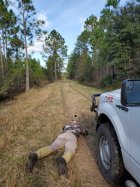Ned Ludd
Silver $$ Contributor

Shooters often refer to group spread or shot displacement using linear measurements, in other words, how far apart the holes were located on the [flat] target face. In trigonometric terms, what we're really refering to is arc length. A given angle subtends a specific arc length for a circle with a defined radius. As illustrated above, the arc length subtended by a given angle for a circle with a defined radius is really not flat, as it is part of the circle. However, at the radii we're typically talking about in shooting discussions, the circle is so large that we consider its arc to be effectively flat over short lengths for the purposes of measuring group size.
Using a milliradian scope is no different that using an MOA scope, milliradians are merely a larger angular adjustment. It is no different than using a scope with 1/8th MOA clicks versus a scope with 1/4 MOA clicks. If one or the other is used regularly, it will become the new normal. When switching back and forth between the Mil and MOA scopes on a regular basis, one may need to keep their wits about them a little more than normal, but it's completely doable.
To use the reticle effectively for adjusting point of impact, one has to be able to see the reticle clearly, and the reticle must be a 1st focal plane, (meaning the reticle changes size as the scope magnification changes) to use effectively at any magnification. In contrast, a 2nd focal plane scope must be set at its "calibration" magnification or some readily convertible fraction thereof (i.e. one half or double). The reticle in a 1st focal plane scope remains proportional throughout the magnification range. The reticle in a 2nd focal plane scope does not change in size as the magnification is changed, thus a 2nd focal plane reticle has to be "calibrated" to represent linear distances (i.e. arc lengths) at some specific magnification. In order to use a 2nd focal plane reticle to estimate necessary scope adjustments based on impacts, the scope needs to be set at the "calibration magnification", or at some fraction of it that can easily be manipulated mentally. For example, if a 2nd focal plane scope reticle is "calibrated" at 40X magnification, one could adjust the point of impact using the reticle with the scope set at 20X, but would have to remember/know that image size with respect to the reticle had been cut in half (i.e. 40X to 20X magnification). Thus, the arc length indicated by the reticle would also need to be halved in order to make the correct scope adjustment. Not having to make such mental calculations is one of the big advantages of a 1st focal plane reticle.











